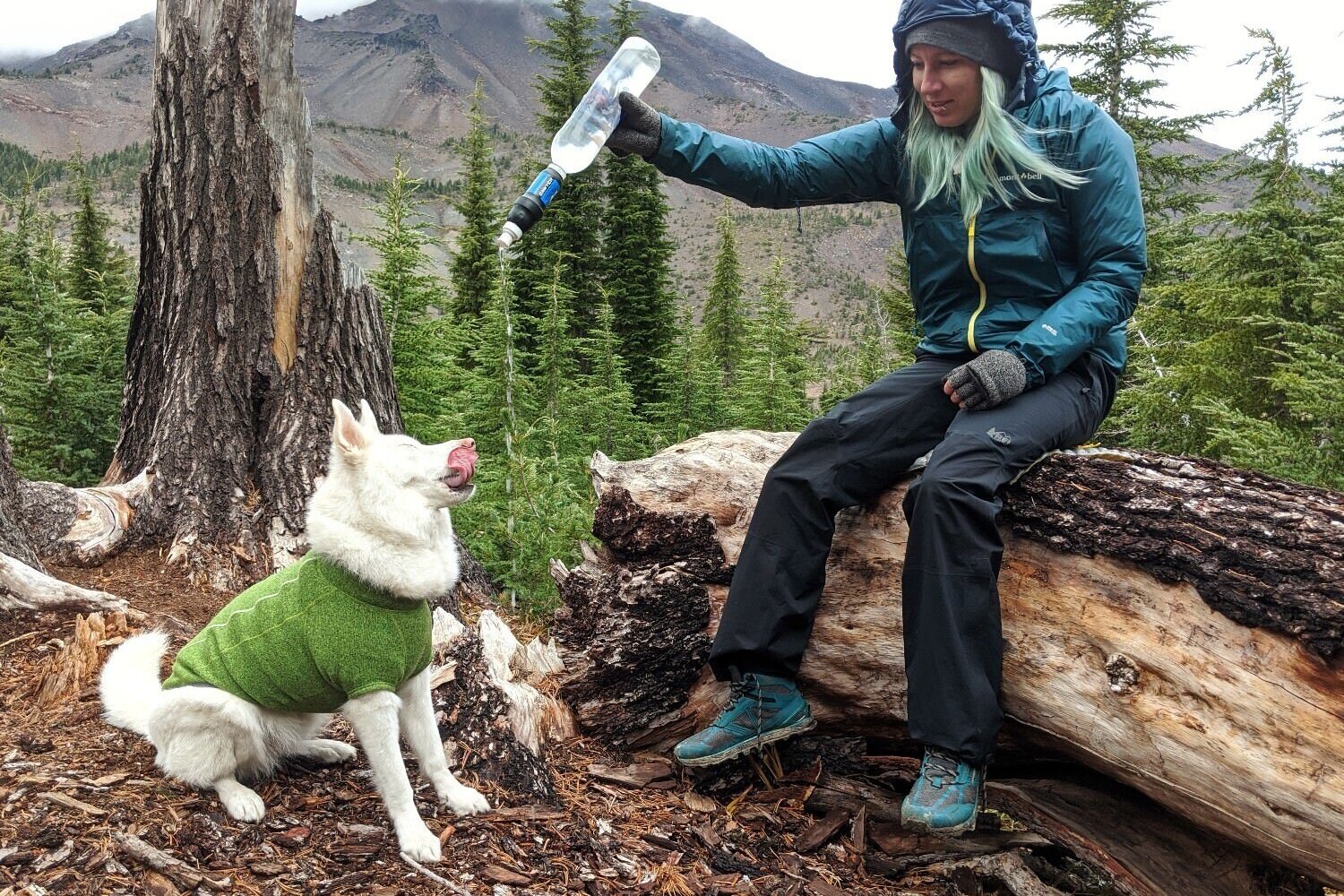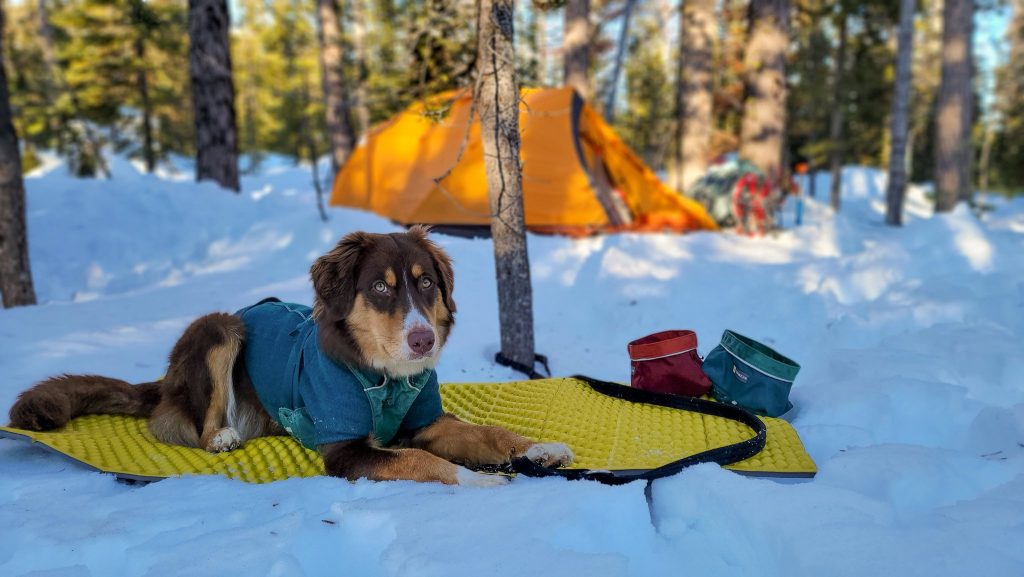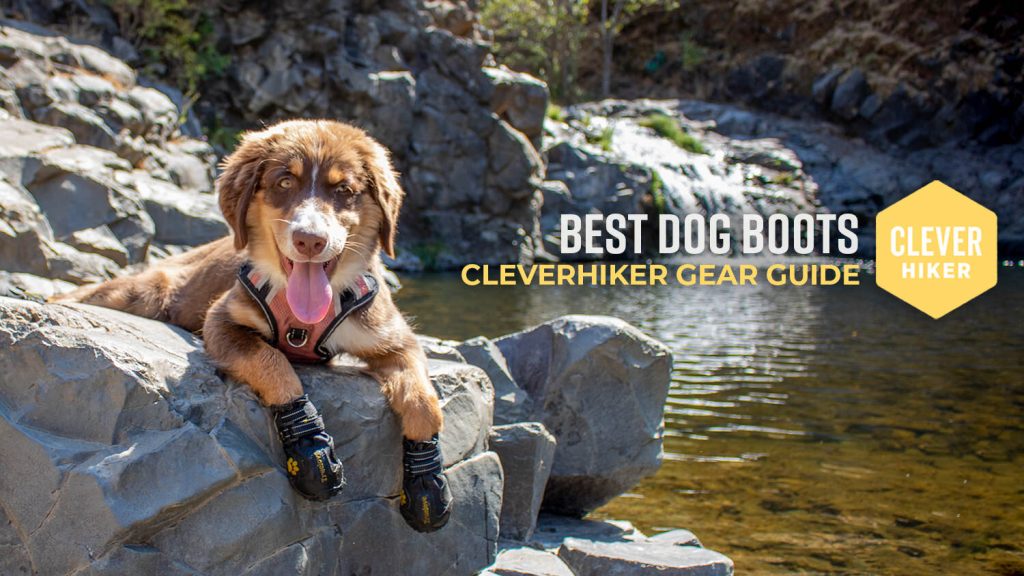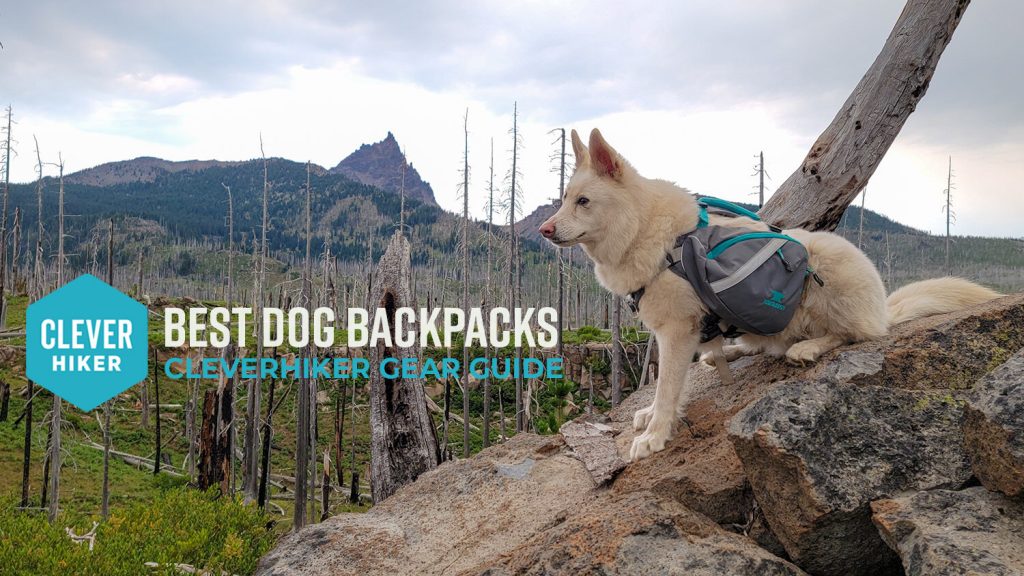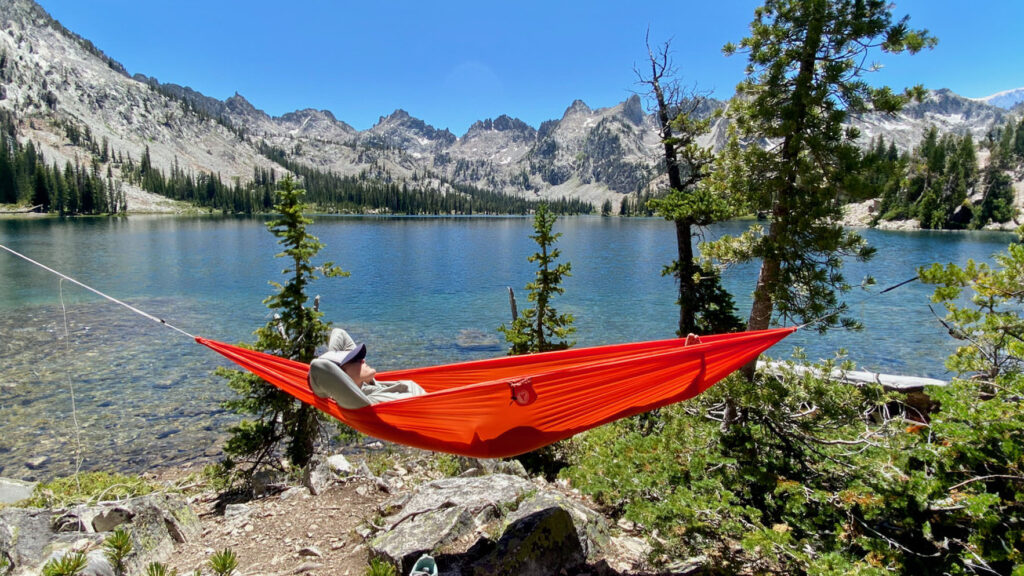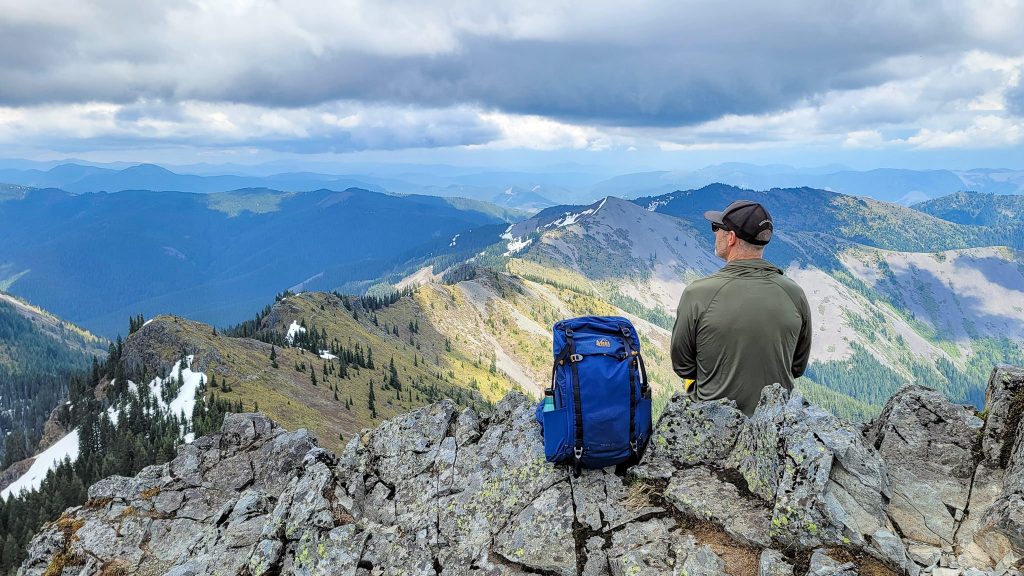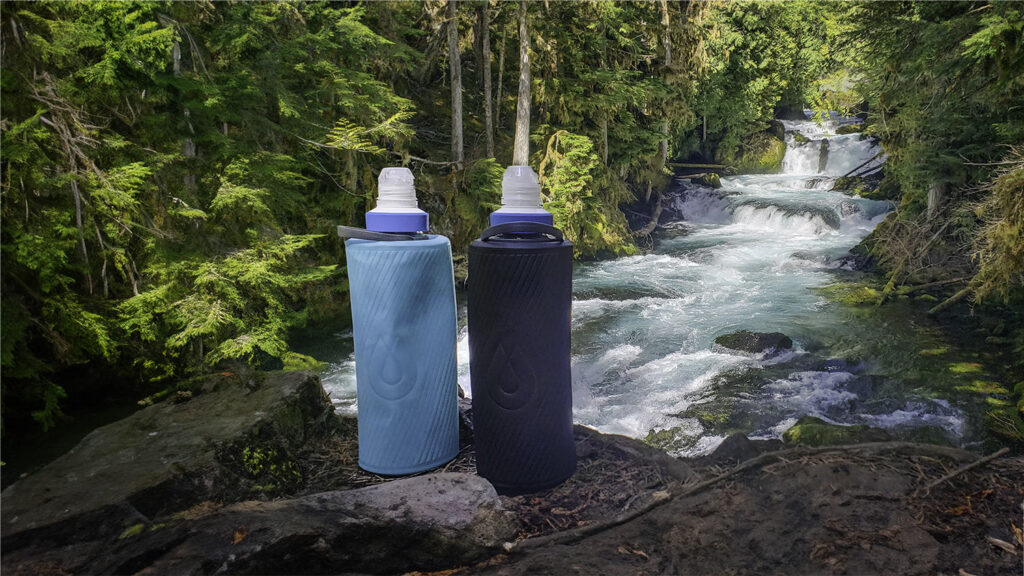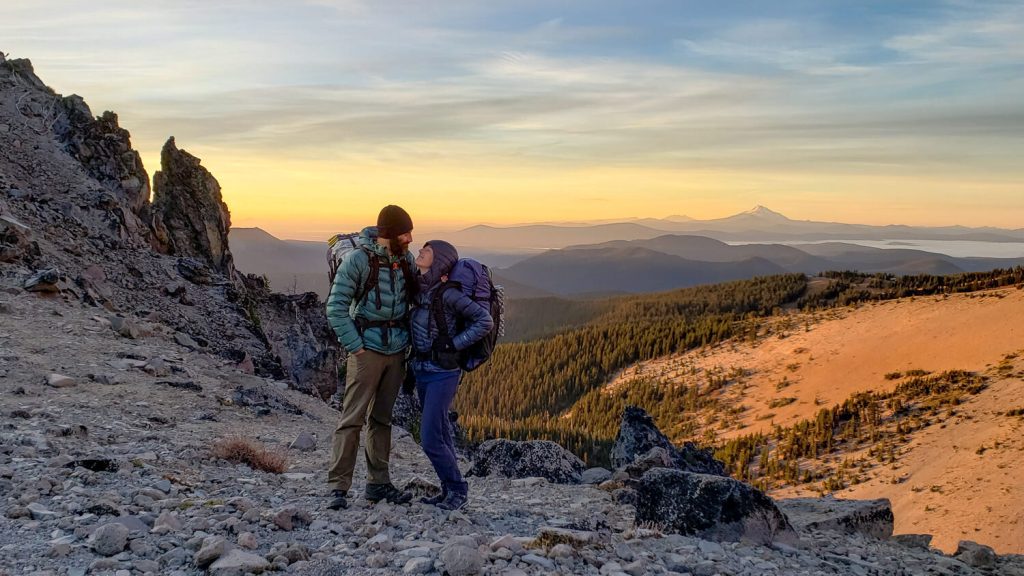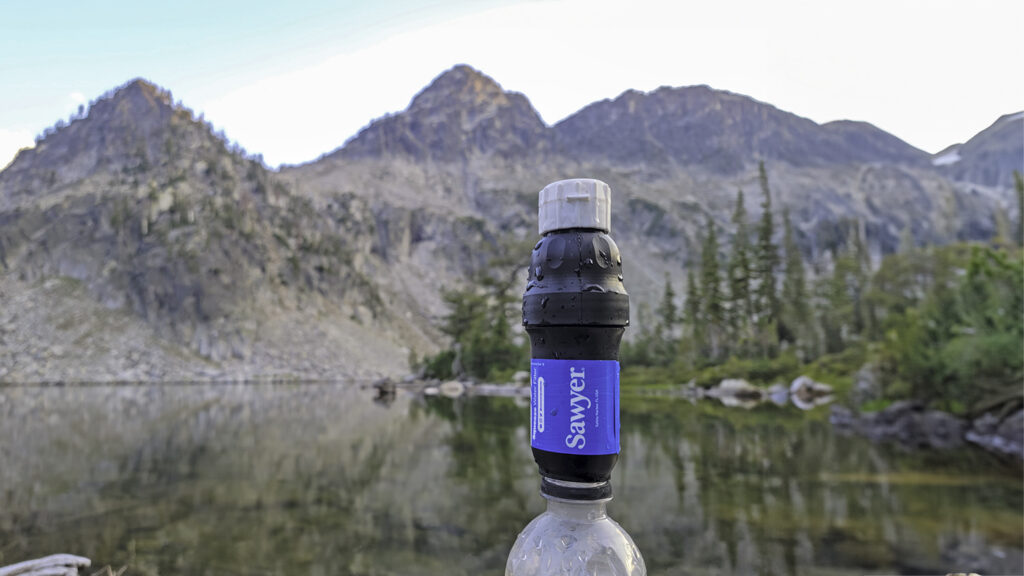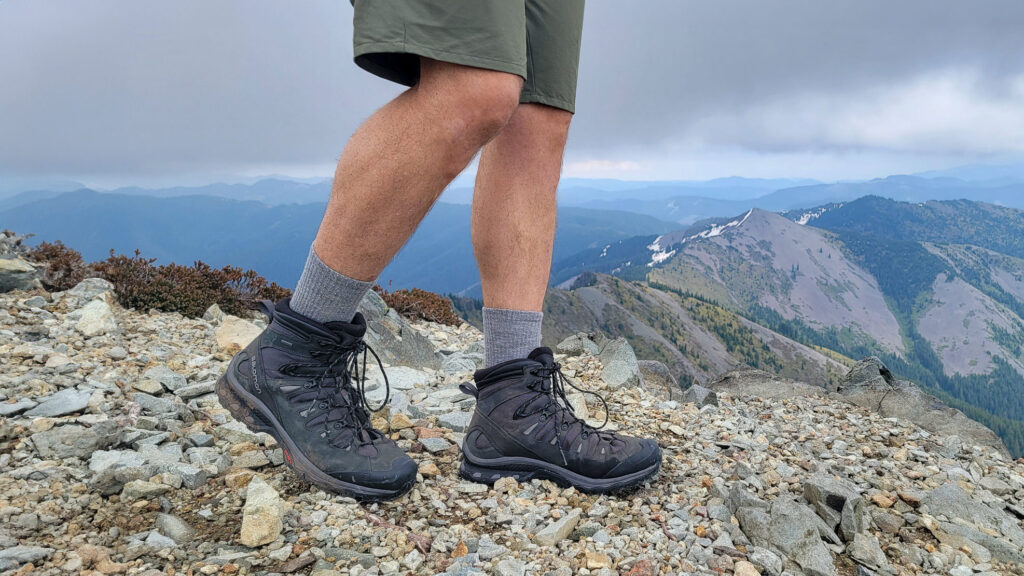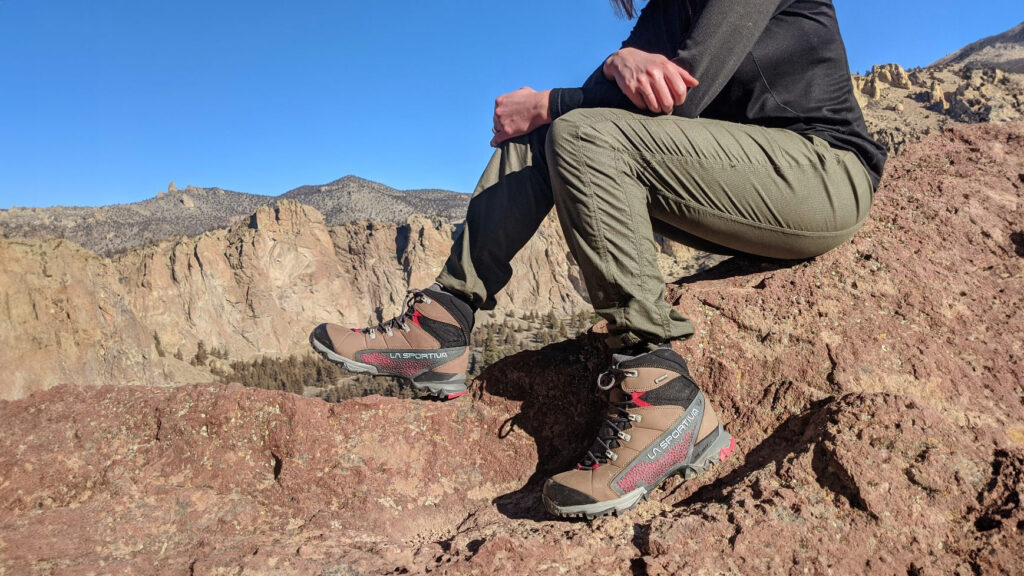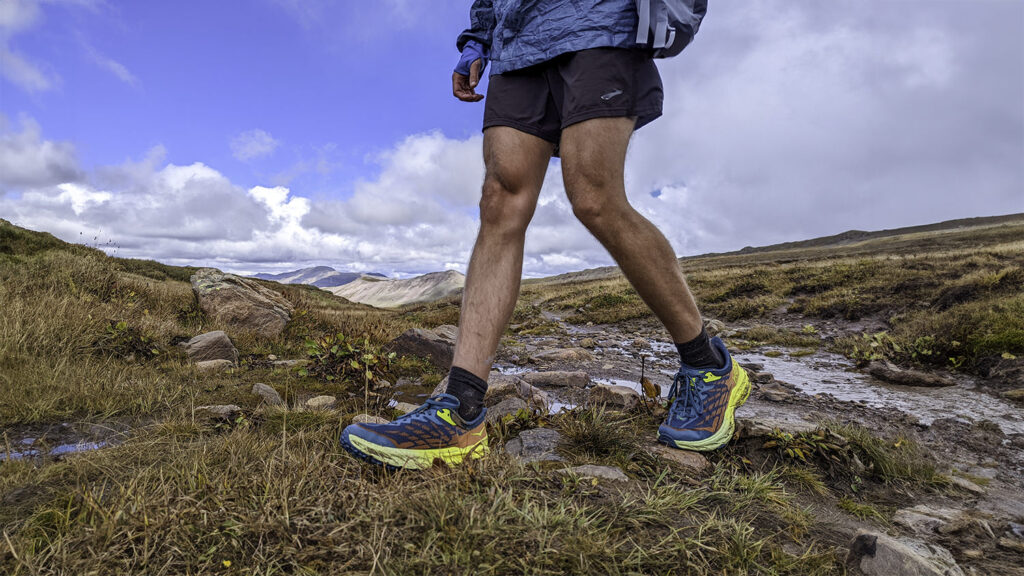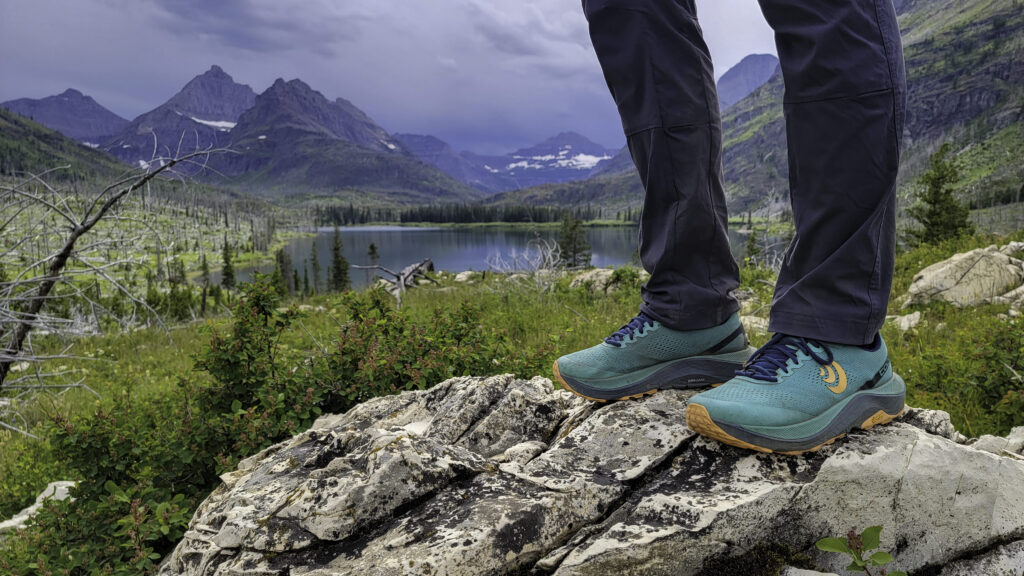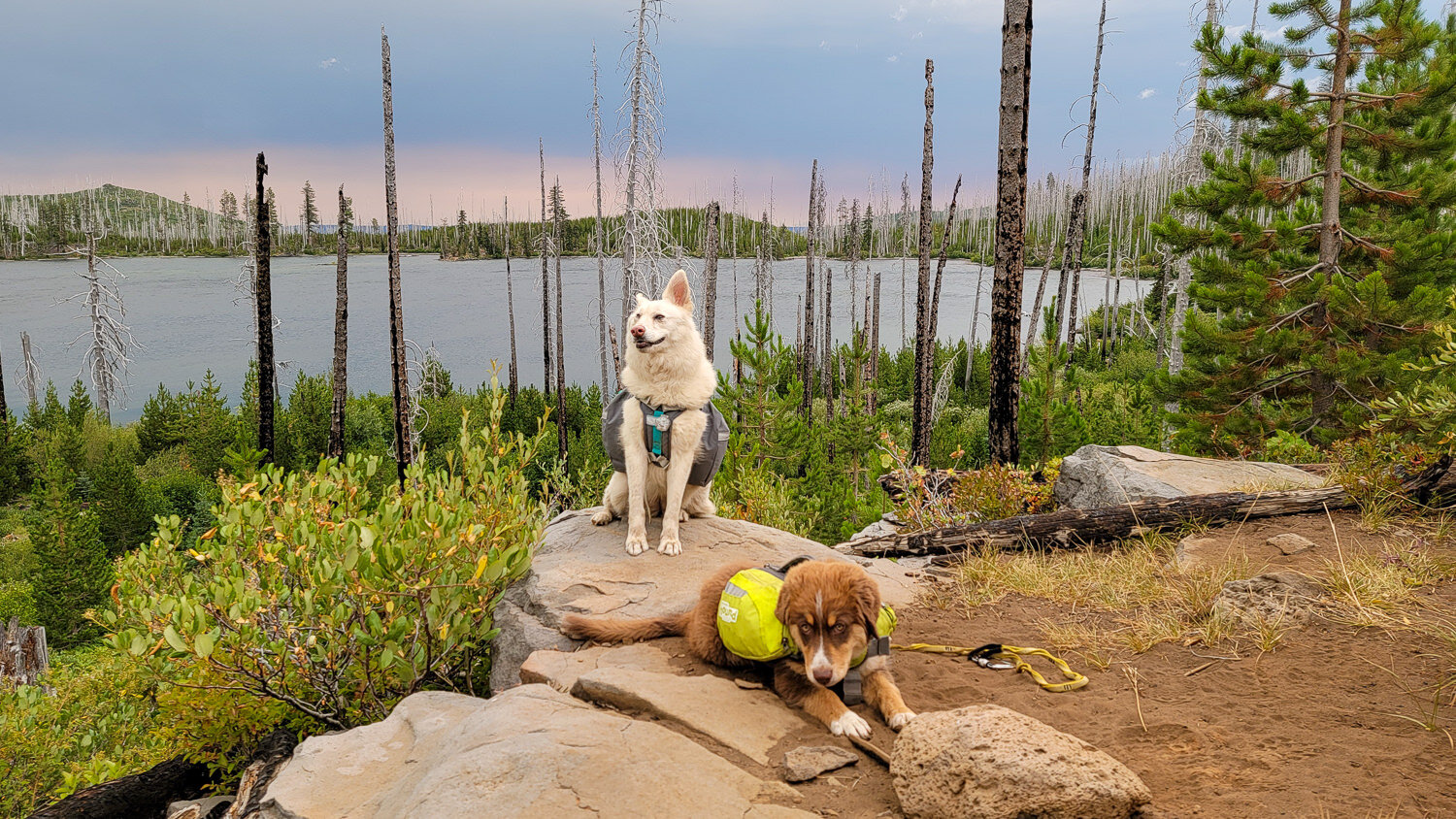
We love getting outside with our dogs whenever possible. Our four-legged friends are always down for adventure, and they’re the most enthusiastic hiking partners we could ask for. But dogs require extra attention and care to make sure the experience is safe and enjoyable for both of you.
Following the tips in this guide will prepare you and your pooch for the trail and build confidence to take them on longer hikes and backpacking trips. After all, a long walk with their best friend is your dog’s dream come true.
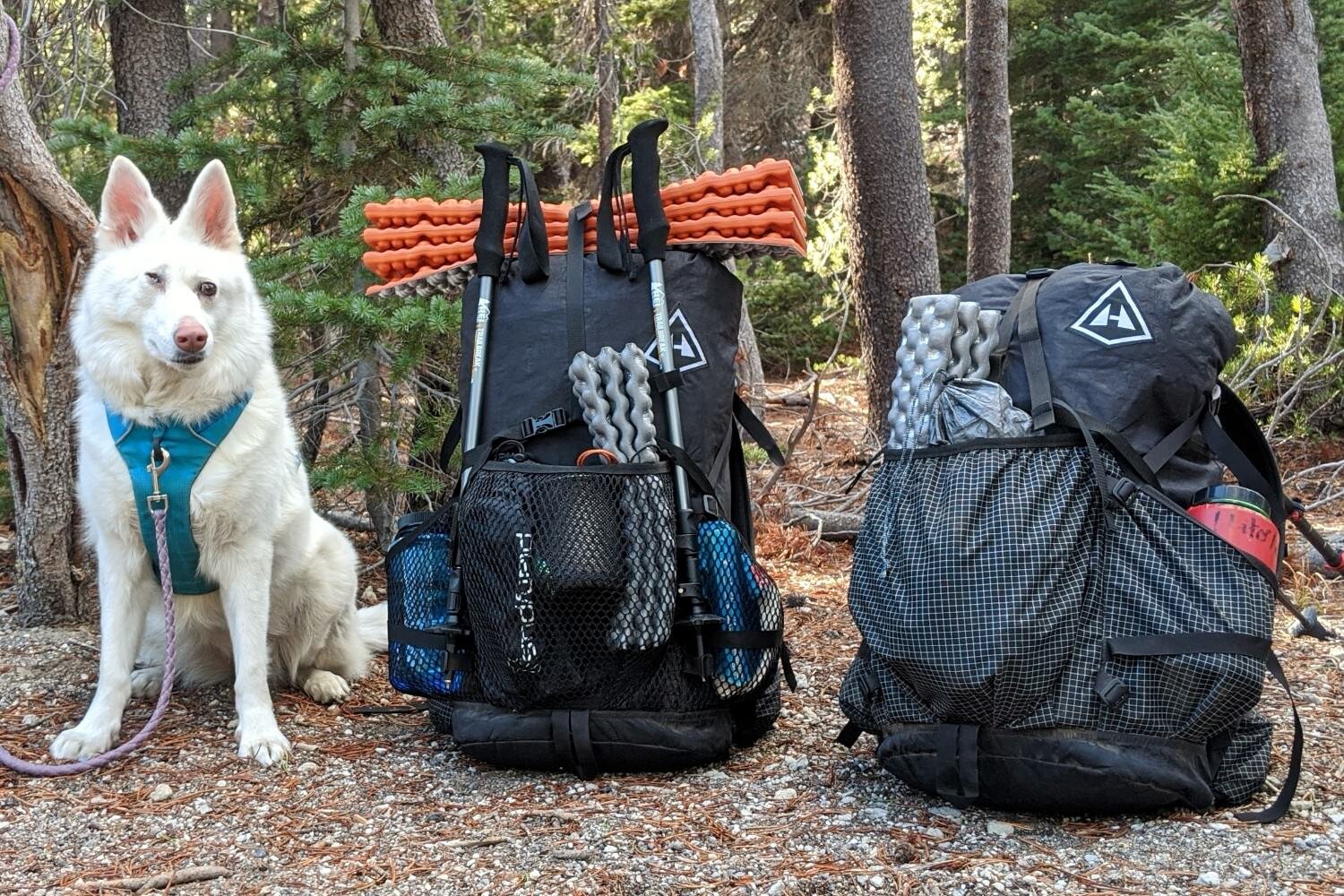
14 Tips For Hiking & Backpacking With A Dog
Keep up with vet visits, vaccinations & Medication
The most important thing you can do for your best bud’s health is take them to the vet regularly. Your veterinarian can go over any concerns you may have about hiking with your dog, and they can provide helpful insights into proper dog first aid. Check with your vet to make sure your dog’s vaccines, heartworm prevention, and flea and tick prevention are all current, as this can help them avoid serious health problems caused by things like a bite from another animal or drinking bad water. And of course, you should have a plan for administering any medication your dog needs on extended hiking trips.
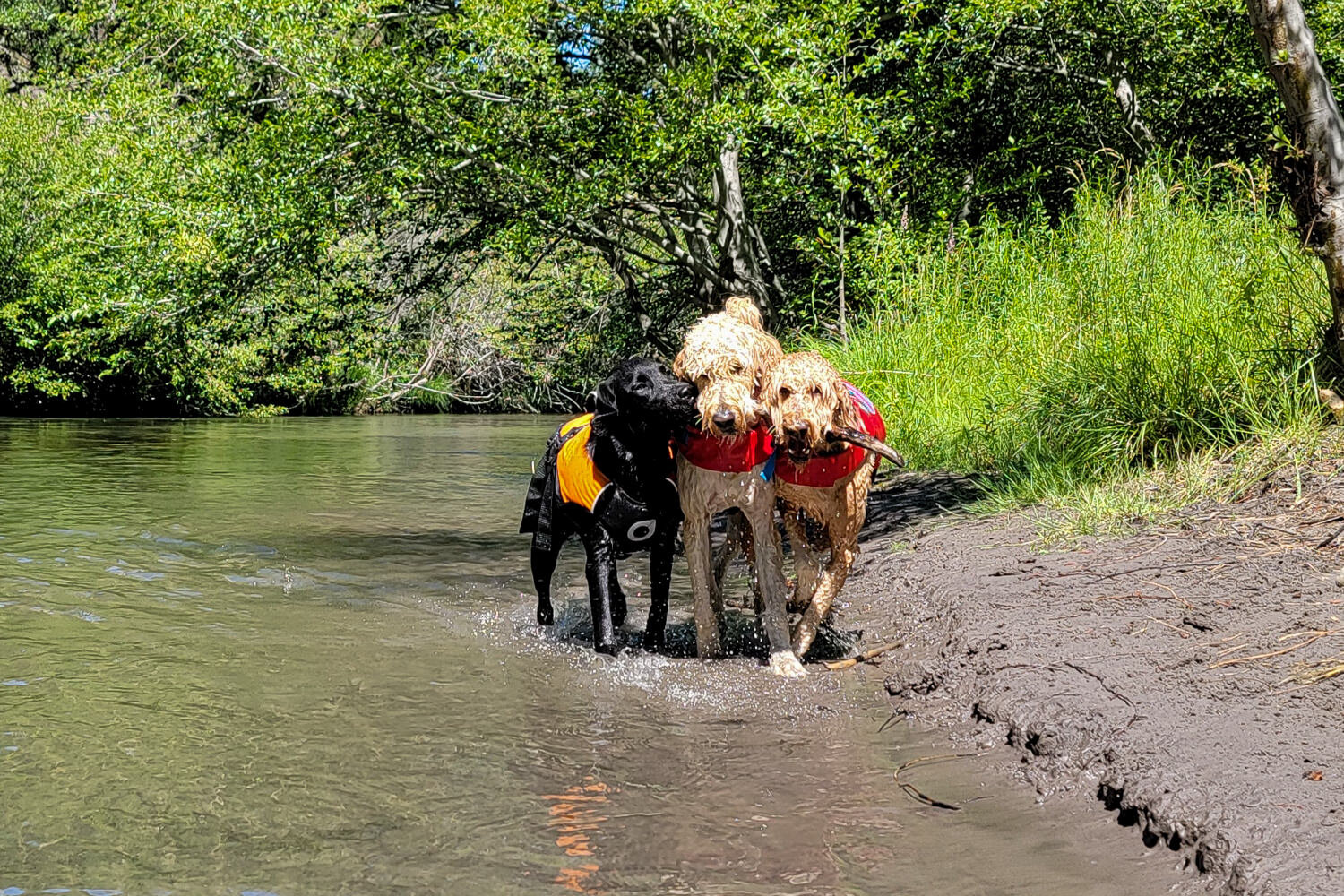
ID Tags & Microchips
Your dog should always be wearing an ID tag with your name and phone number while on trail, and it’s best practice to also have them microchipped in case the worst should happen and they get lost.
Know your Dog’s Limits
Dogs aren’t always great at telling us when they’re in pain or uncomfortable, so it’s important to keep an extra close eye on them when you’re out on a challenging hike, especially if the weather’s hot. Some signs of distress include excessive panting, loud breathing, and lagging behind. If you notice these behaviors, take a good long rest in the shade and offer plenty of water and a snack. While backpacking, your dog should always be the one who ultimately determines how many miles you do for the day if they need to stop before you hit your goal.
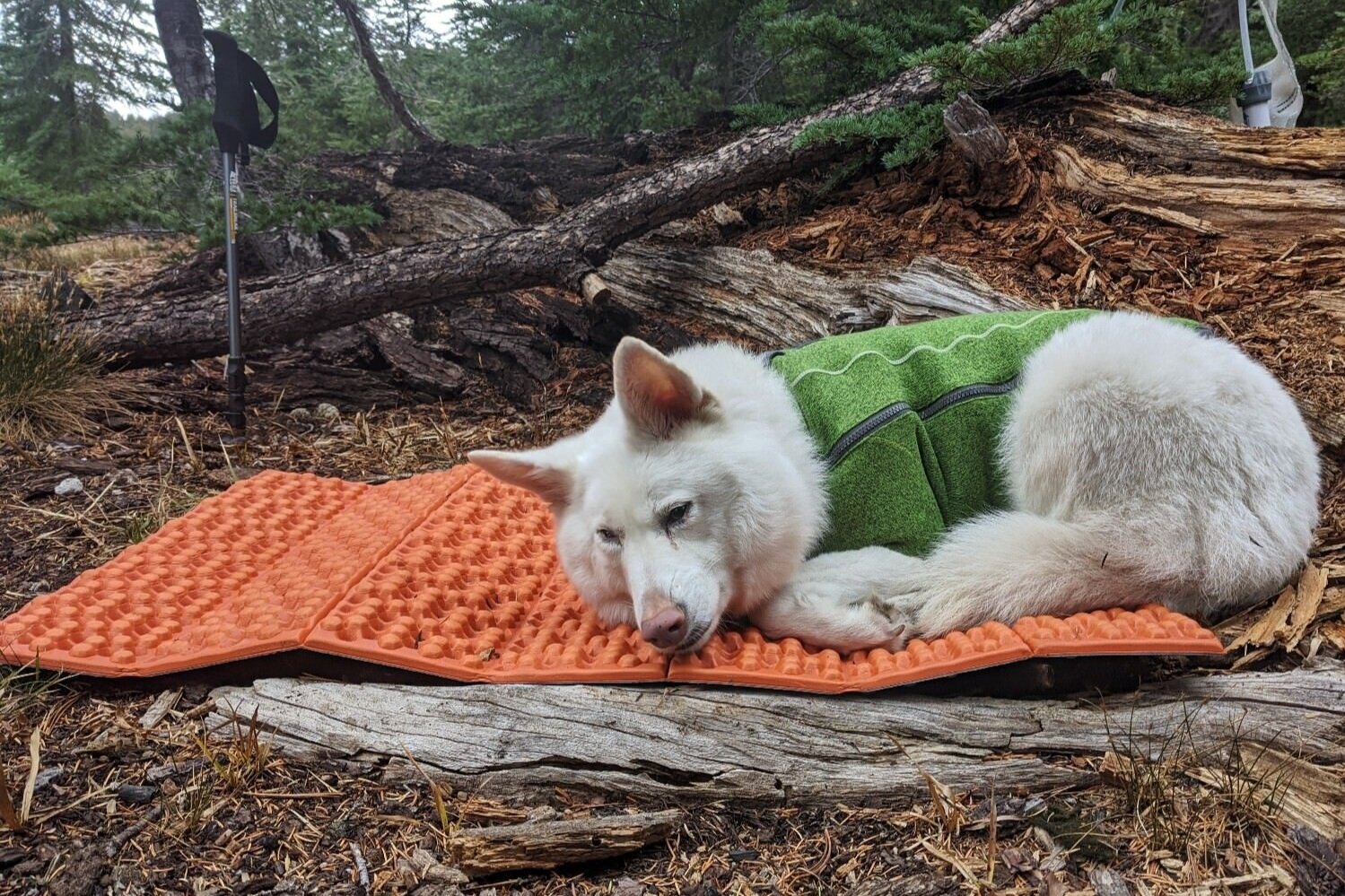
Be Prepared to Keep your Dog on a leash
Many wilderness areas require dogs to be leashed, usually on a lead no longer than 6 feet, for a number of reasons. Often these rules are in place to protect wildlife or sensitive ecosystems. Or it could be that it’s a high-traffic area, and keeping your dog on a leash will help others enjoy their time on trail. Whatever the reason may be, it’s important to follow these rules for the safety of you, your dog, other hikers, and local flora and fauna. In areas where leashes aren’t required, it’s still a good idea to leash your dog near fast moving water, steep drop offs, or when you see another trail user (whether it’s another hiker or wildlife). Keep in mind that your dog may be very friendly, but that doesn’t mean all dogs are or that everyone wants your dog to approach them.
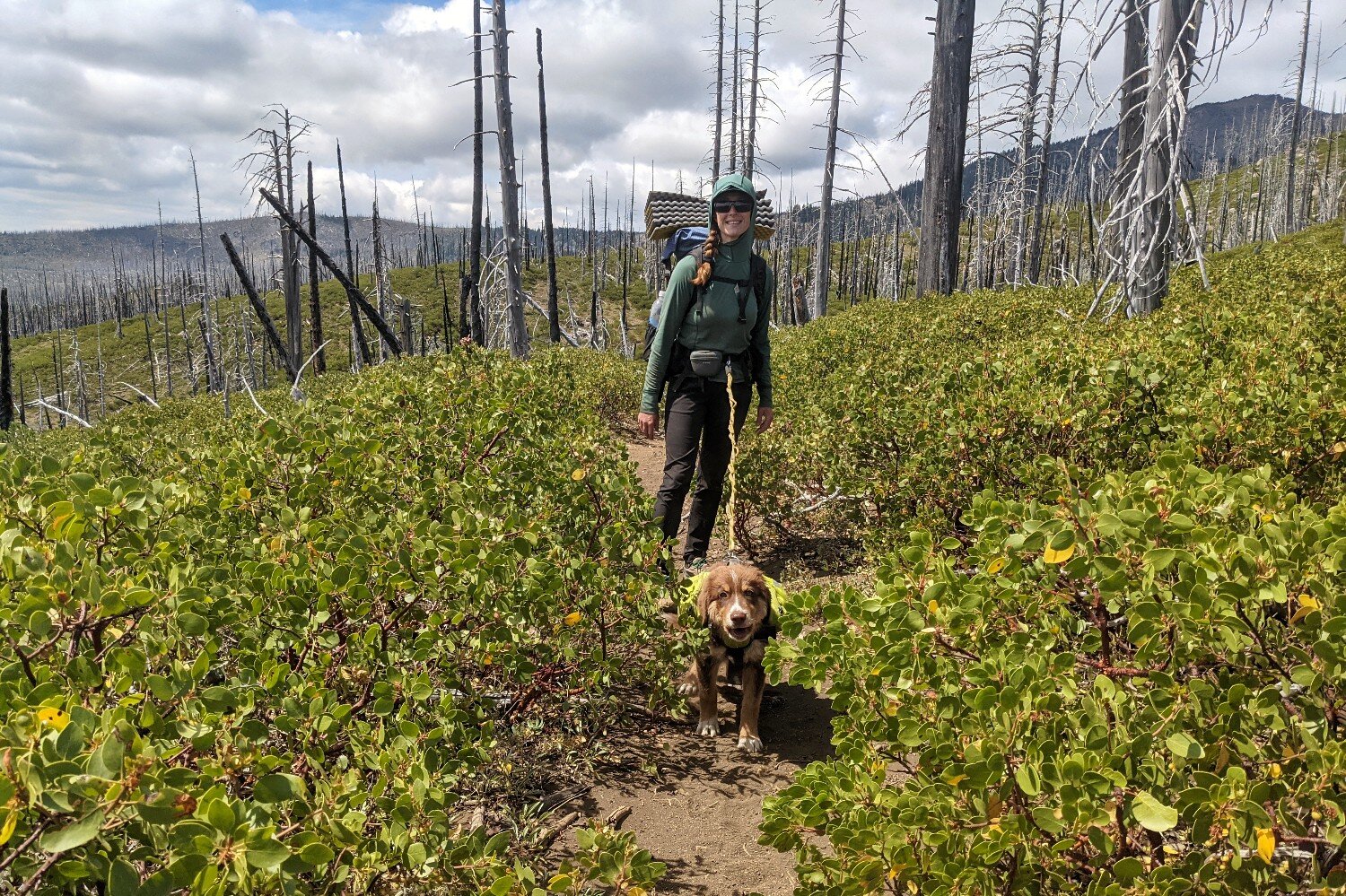
Don’t take your dog where it isn’t allowed
Similar to the reasons an area may require you to keep your dog on leash, some outdoor spaces don’t allow dogs at all. Never take your dog anywhere that they’re prohibited or you could damage a sensitive area, disturb a protected species of wildlife, and/or end up with a fine to pay.
Do some training with your dog ahead of time
Before you head into the wilderness, work with your dog on basic commands. We recommend having your dog be proficient with come, leave it, sit, and stay. Good recall (come) is especially important if your dog is going to be off-leash at all so you can call them back if they wander a little too far from you or you need to leash them quickly. “Leave it” is also important so you can regain their attention if they’re tempted to chase wildlife or nibble at something potentially dangerous. Remember to train for the situation in a controlled environment beforehand, not in the actual situation. When the time comes to put your dog’s skills to the test on the trail, make sure you pack along plenty of training treats to reward good behavior.
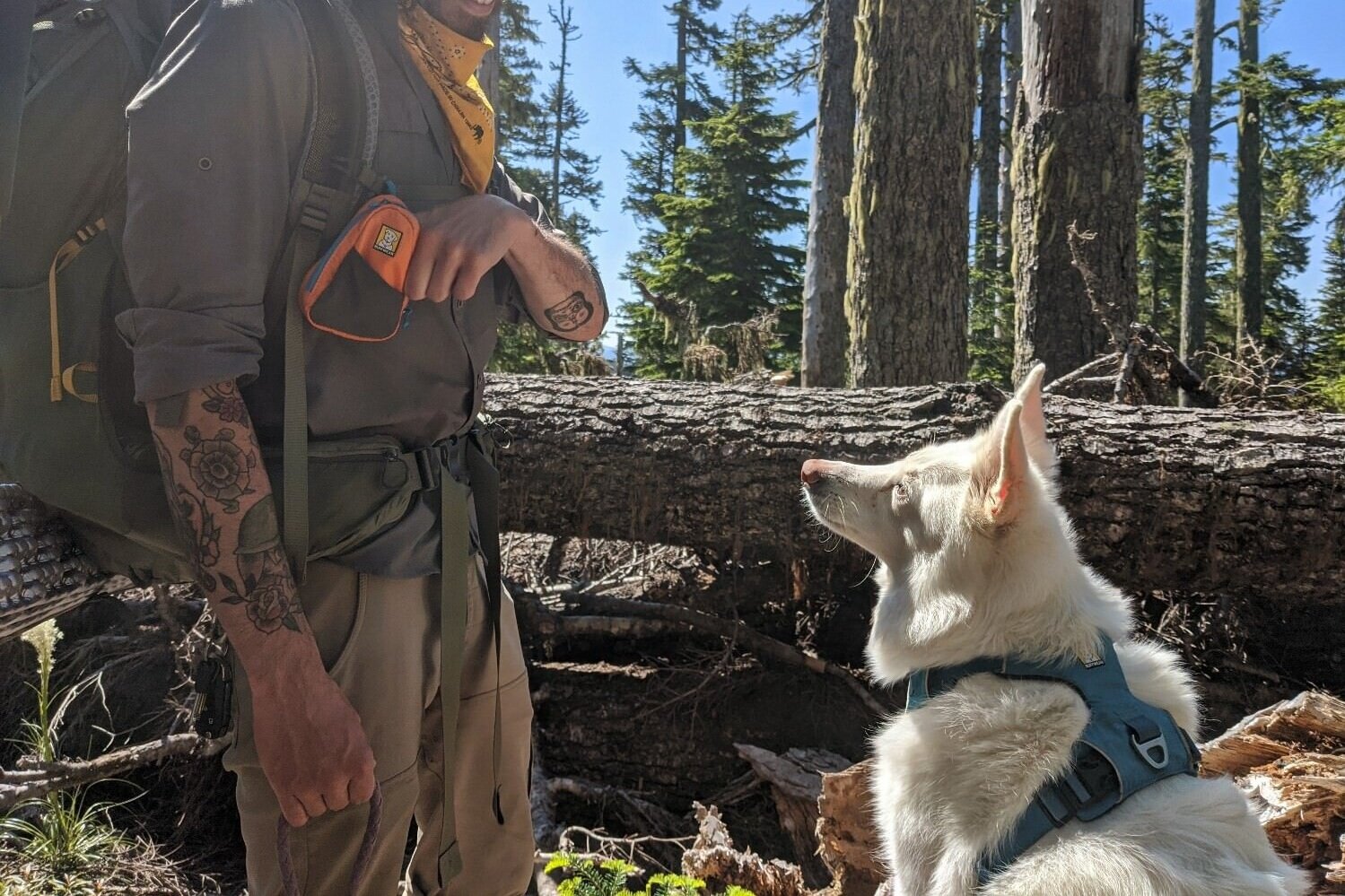
Start Small
If your dog is new to hiking, it’s best to start with a short, simple trail. Most dogs seem to really enjoy going for a hike, but not every dog has the energy to walk for multiple miles. If you want to eventually take your dog on longer overnight trips, work up to bigger mile days on trails close to home before heading out to the backcountry.
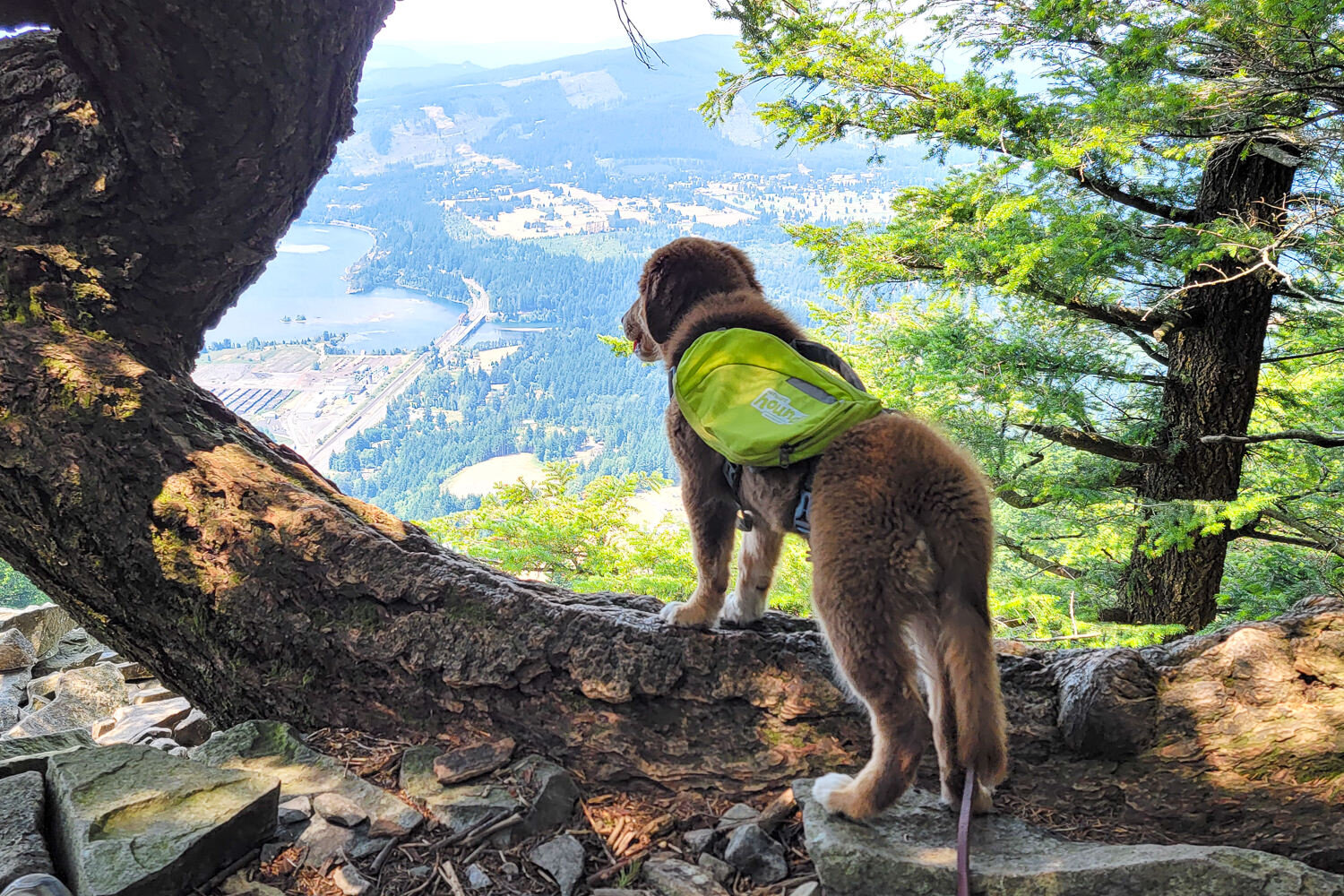
Puppies & Older Dogs
It’s important to remember that puppies and older dogs – especially those with health challenges – will likely require extra support from you on trail. Let your dog set the pace and remain patient with them. For smaller dogs and puppies, it’s a good idea to get a dog carrying backpack so your pooch can enjoy hikes with you even when they can’t handle the distance on their own.
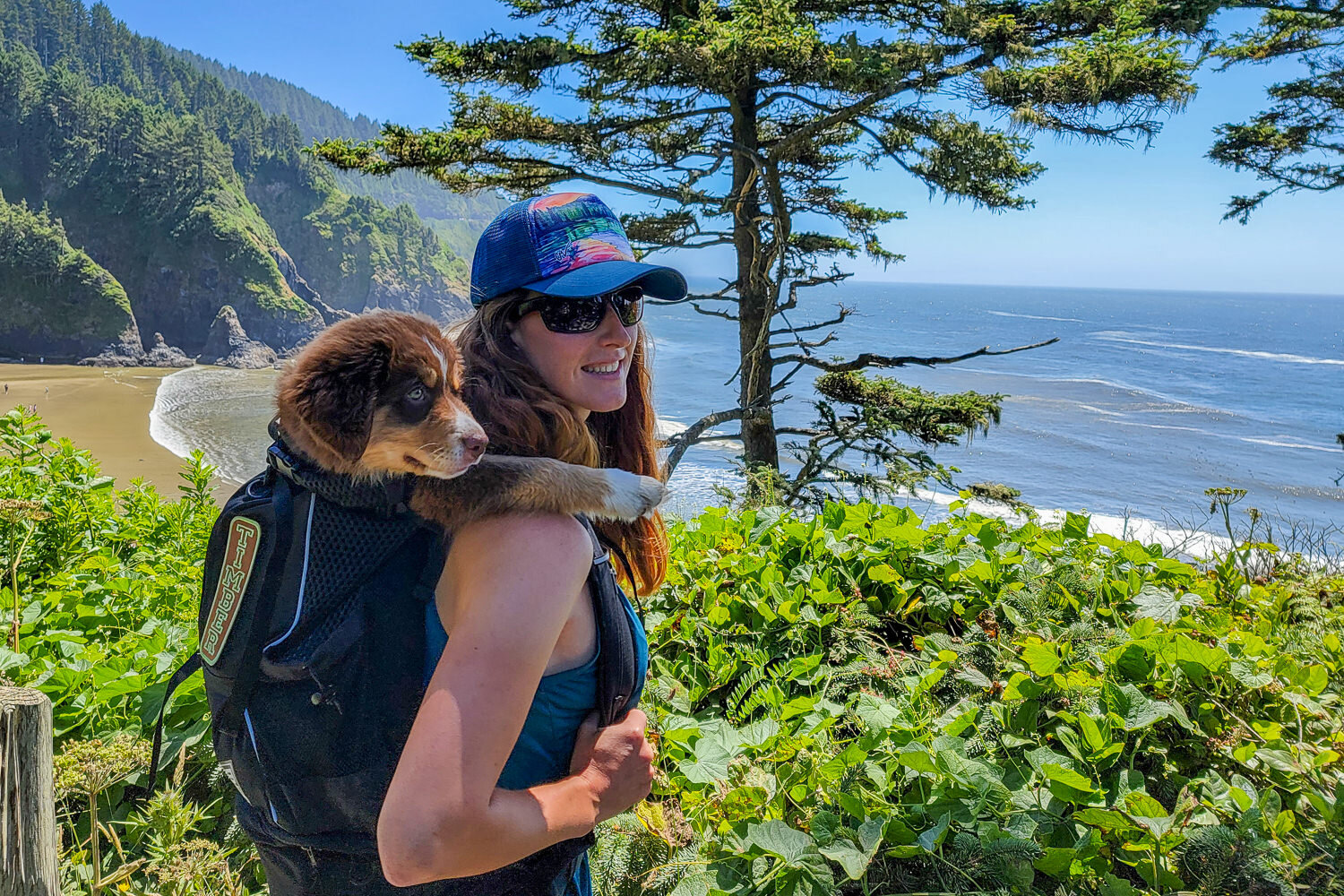
Dealing with pet waste
When your dog does it’s business, you should treat it just like you would your own in the backcountry. If you’re in an area where it’s safe to bury your waste, you may also bury your dog’s waste (in a hole 6-8 inches deep). In areas where you need to pack out your waste (like alpine areas and environmentally sensitive spaces), you should also be packing out your dog’s waste. Leaving it on the ground isn’t just gross for other users of the area, but it can also destabilize the ecosystem because you’re introducing foreign matter into the soil and water systems. If we’ll be be packing it out, we usually bring a gallon ziplock or an Loksak bag with us to isolate the doody bags from the rest of our stuff in an outer pocket of our backpack. If your dog carries a backpack, you could also line one of the pockets with a plastic bag and have them carry out their own poop bags. You should always bear-hang your dog’s poop with the rest of your smellies when backpacking in bear country. And please don’t leave poop bags on the side of the trail with the plan to grab them on the way out.
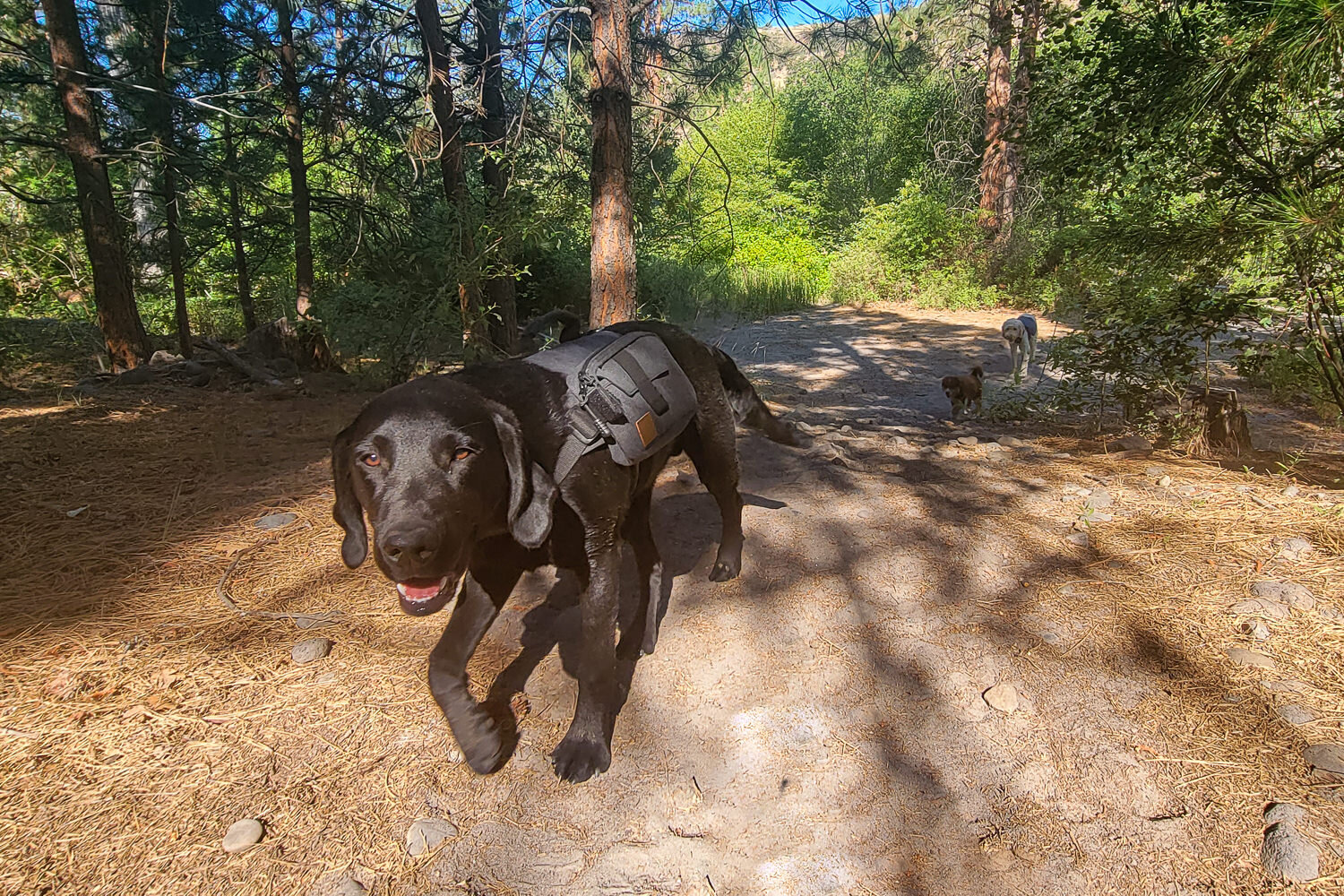
Food & WAter
Dogs need extra calories and hydration for hiking just like we do. Our dogs typically get a snack anytime we stop to eat on trail. We pack high-calorie foods like peanut butter, jerky, and cheese to reward their efforts and keep up their energy level. You may also want to feed them a slightly larger portion for their regular meals if you’re hiking a lot of miles or on a multi-day backpacking trip. It’s best to ask your vet how many calories they recommend feeding your dog on your trip. As for water, you should be filtering all of the water you offer your dogs in the backcountry. Though a serious infection is more rare, dogs are susceptible to many of the same water-borne illnesses we are, like Giardia and Cryptosporidium.
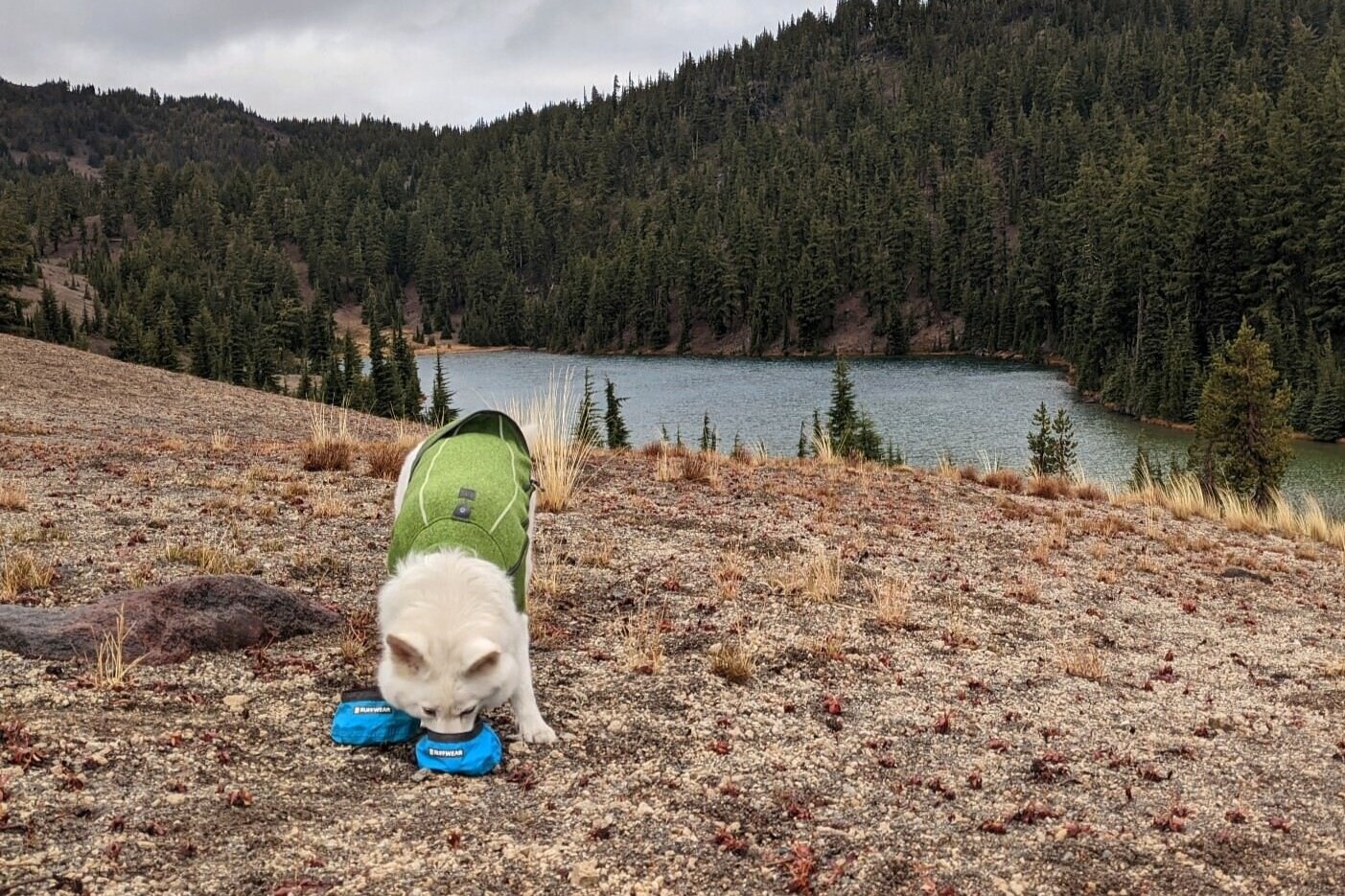
Have a First Aid Kit & Know how to use it
If you take the proper precautions, you’ll greatly reduce the risk of anything going wrong on your hike. That said, things do happen so you should always carry a
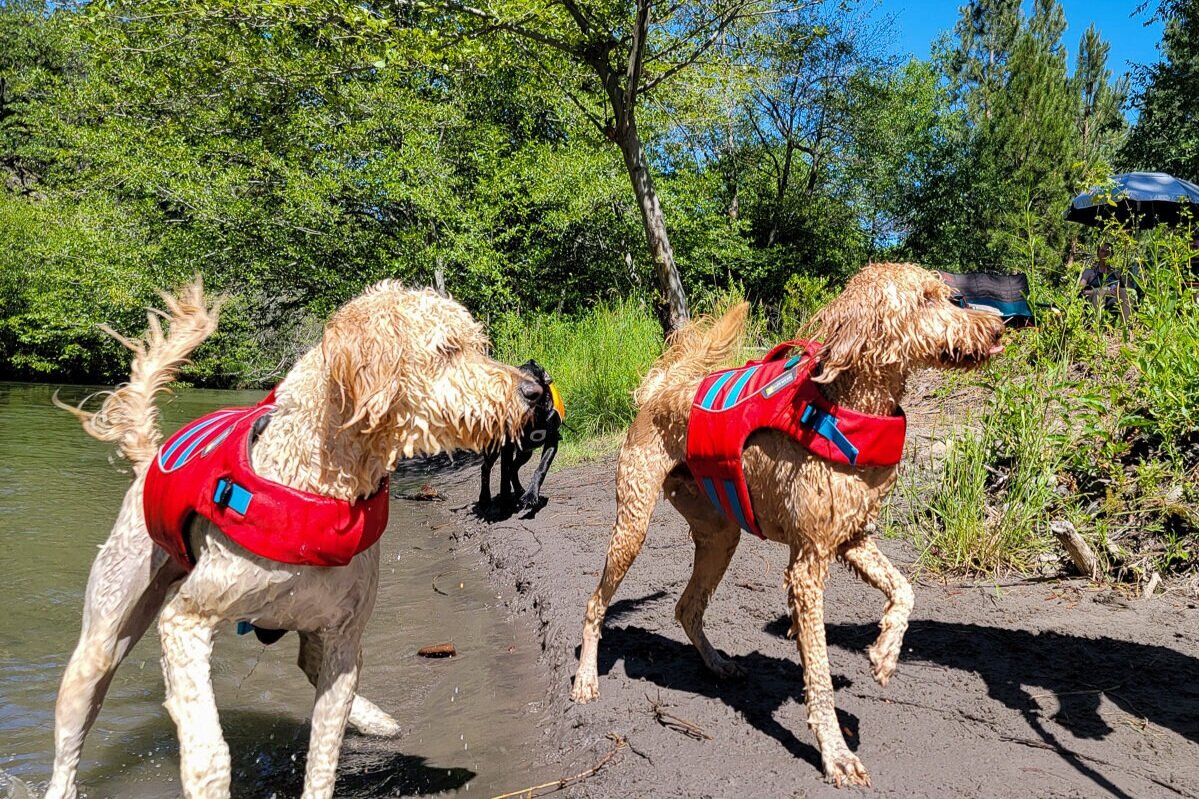
Avoiding trail hazards
Take extra care to protect your dog around hazards like wildlife, swift water, steep ledges, and thin ice. The best way to ensure your dog’s safety around these dangers is to put them on a leash. During hunting season, put a brightly colored reflective vest and a
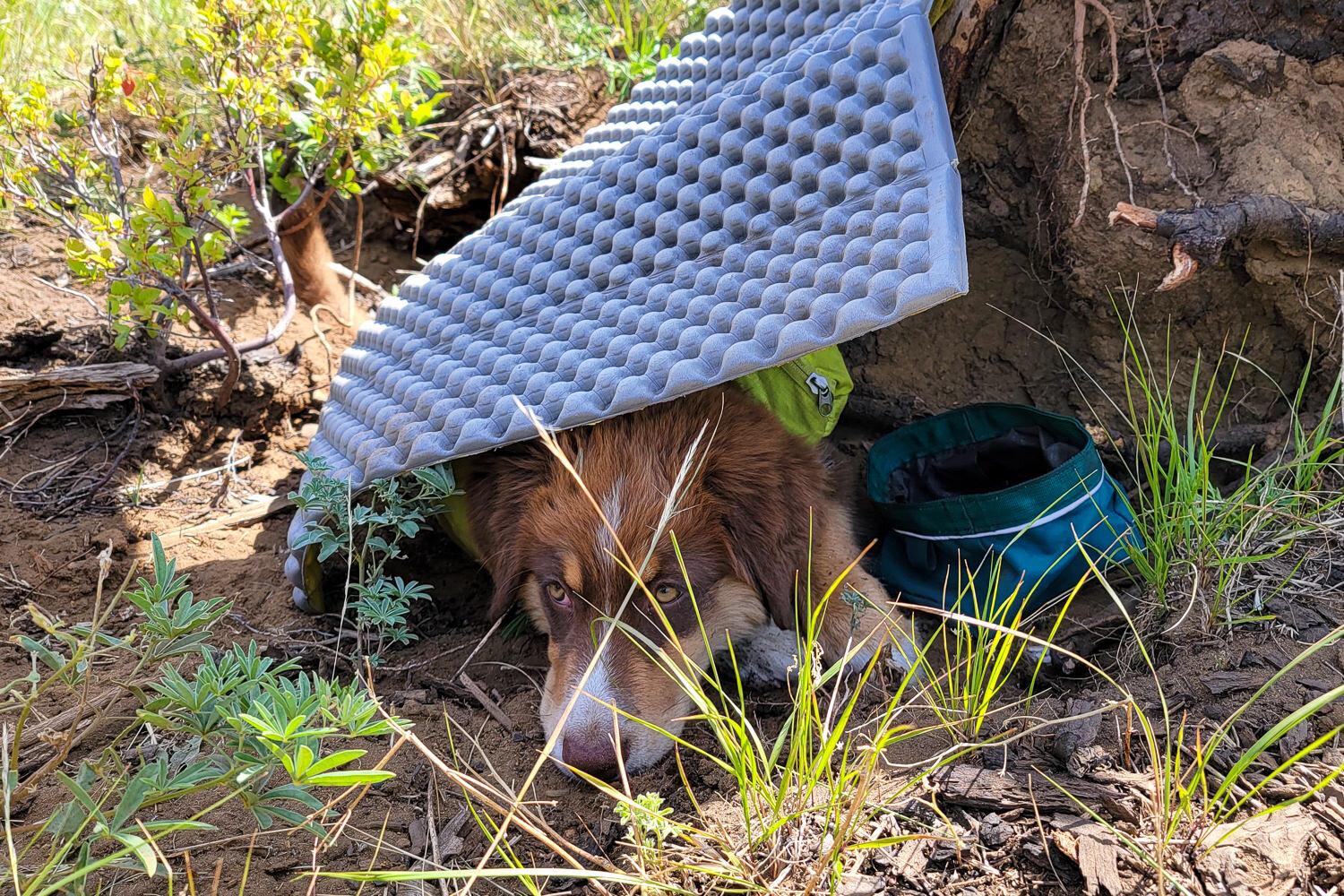
Protect their paws
You likely wouldn’t hike over rough terrain barefoot, and it’s better for your dog not to either. Dogs can develop painful blisters and tears on their paw pads if proper care isn’t taken. For rocky and abrasive (like volcanic landscapes) terrain, we put hiking boots on our dogs to protect their pads. For snow, sand, ice, and trails where the ground gets very hot (like paved trails and desert sand), we use Musher’s Wax to keep the paws from burning or collecting blister-causing debris.
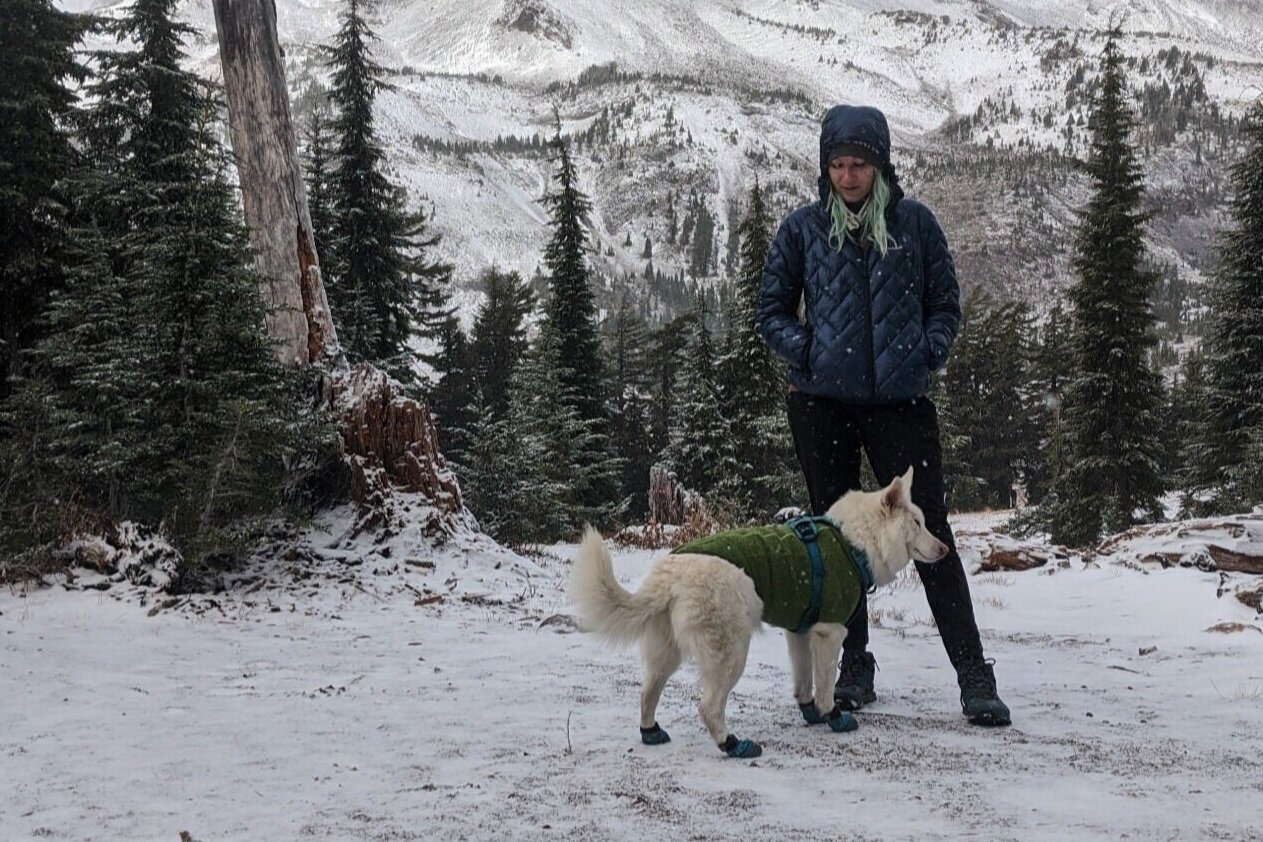
Protect Your Gear
If you use lightweight gear, you know that some of the materials can be pretty delicate. Dog claws and teeth can have a devastating effect on your equipment, so it’s important to teach dogs that your outdoor gear is not their toy. In the tent, we keep socks on our dogs to protect our inflatable sleeping pads, sleeping bags, and tent floor from their claws.
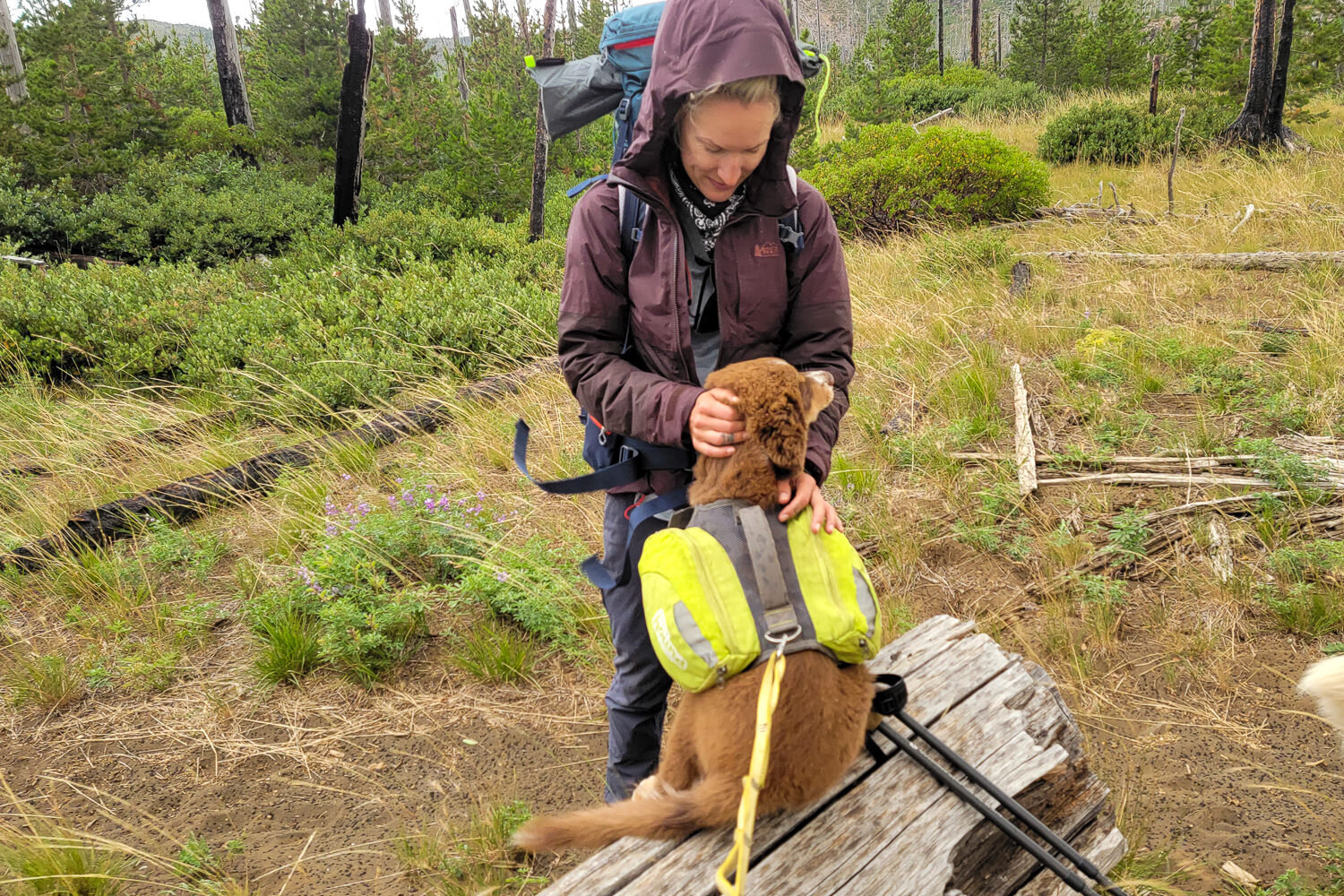
Gear Checklists
Now that you know how to keep your dog safe and happy on the trail, what exactly should you bring? Here are the go-to items we bring on most of our trips:
Dog Gear Checklist for Day Hikes
- Any important medications
- An extra meal for your dog in case you’re out longer than you plan
- First aid kit
- Daypack (optional)
- Leash
- ID tags
- Light collar
- Poop bags
- Training treats
- Food and water bowls
- Extra water for the dog or way to filter on trail
- Treat Pouch
- Snacks (peanut butter, jerky, or cheese)
- Boots or Musher’s Wax (optional depending on terrain)
- Pack towel
- Toy (optional)
Clothing to suit the conditions
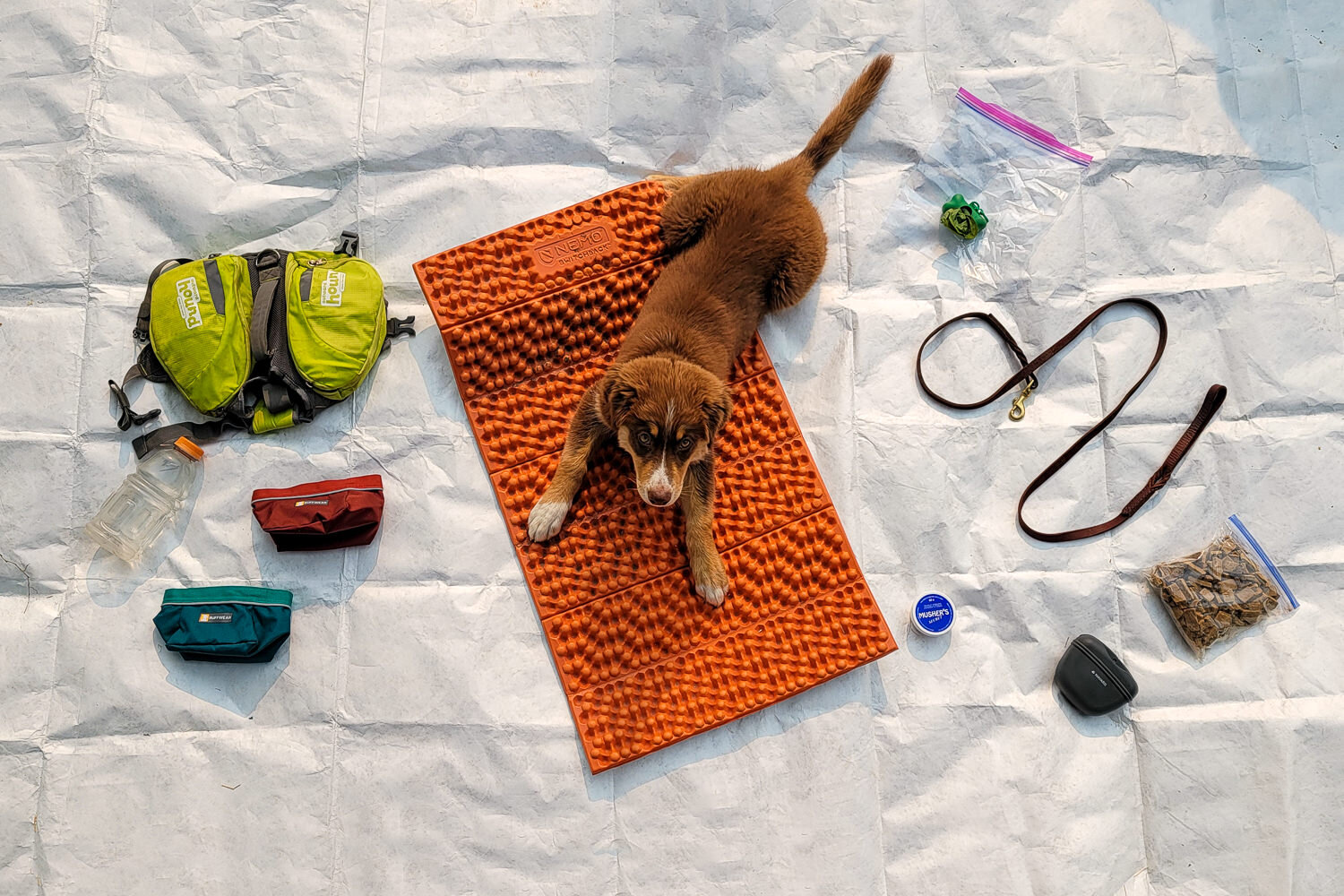
Dog Gear Checklist for Backpacking
- Any important medications
- Plenty of food (we pack ours in ziplocks or dedicated food bags)
- First aid kit
- Backpack (if your dog carries their own gear)
- Leash
- ID tags
- Light collar
- Poop bags
- Training treats
- Food and water bowls
- Treat pouch
- Snacks (peanut butter, jerky, cheese, etc.)
- Boots or Musher’s Wax (optional depending on terrain)
- Closed-cell foam pad; cut to size (we use this to keep them out of the dirt in camp and for them to sleep on in the tent)
- Dog sleeping bag or blanket (if you don’t want to share your sleeping bag on chilly nights)
- Socks / boot liners (for in the tent and/or to wear in conjunction with boots)
- gallon ziplock (for containing poop bags)
- Pack towel
- Toy (optional)
Clothing to suit the conditions
